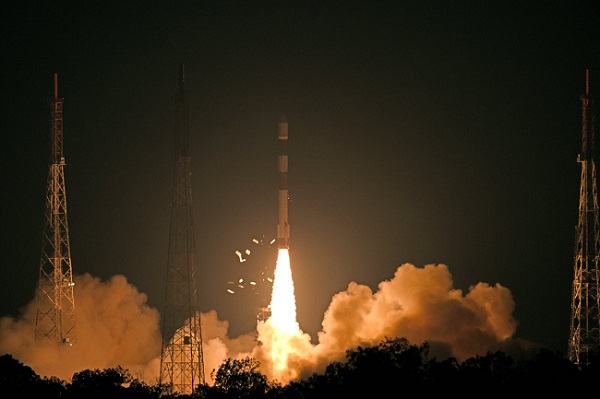 English
English

Indian Space Research Organisation on Wednesday put earth observation satellite RISAT-2B into orbit to help boost the country’s surveillance capabilities, among others.

Sriharikota: In yet another major feat, Indian Space Research Organisation (ISRO) on Wednesday put earth observation satellite RISAT-2B into orbit to help boost the country's surveillance capabilities, among others.
Polar Satellite Launch Vehicle (PSLV-C46) lifted off at 05:30 am from the Satish Dhawan Space Centre here and injected RISAT-2B into an orbit of 556 km, about 15 minutes and 25 seconds after the launch, an ISRO statement said.
Also Read: ISRO's PSLVC-45 successfully injects EMISAT into sun-synchronous polar orbit
After the automatic deployment of the solar arrays of RISAT-2B, ISRO's Telemetry Tracking and Command Network (ISTRAC) at Bengaluru assumed control of the satellite. In the coming days, the satellite will be brought to its final operational configuration.
?? #ISROMissions ??#PSLVC46 successfully injects #RISAT2B into Low Earth Orbit.
Here's the view of #RISAT2B separation captured by our onboard cameraOur updates will continue. pic.twitter.com/WUTBdNH2XJ
— ISRO (@isro) May 22, 2019
This was the 72nd launch vehicle mission from the Sriharikota Range, the statement said.
"RISAT-2B is a radar imaging earth observation satellite weighing about 615 kg. The satellite is intended to provide services in the field of agriculture, forestry and disaster management," it said.
Also Read: ISRO successfully launches GSAT-11 communication satellite
ISRO officials said RISAT-2B also has surveillance capabilities. The satellite will have a life of five years, they said.
ISRO Chairman K Sivan congratulated the scientists and technicians involved in the mission. "With this launch, PSLV has lofted 50 tonnes into space by launching 354 satellites, including national, student and foreign satellites," he said.
Sivan also commended the efforts of the teams involved in the development of piggyback payload carried onboard this mission, namely Vikram processor and low-cost MEMS-based Inertial Navigation System (INS) by Semi-Conductor Laboratory (SCL), Chandigarh and ISRO Inertial Systems Unit, Thiruvananthapuram respectively.
He said, "RISAT-2B is an advanced earth observation satellite with the advanced technology of 3.6m radial rib antenna."
#ISROMissions#PSLVC46 lifts-off from Sriharikota.
Here's a shot of the first stage separation.
Stay tuned !!! pic.twitter.com/qJ20Zfprmr
— ISRO (@isro) May 22, 2019
Over 5,000 visitors witnessed the launch live from the viewer's gallery.
ISRO is now gearing up for the launch of Chandrayaan-2 onboard GSLV MkIII during the window of July 9 to July 16, with an expected moon landing on September 6.
"Chandrayaan 2 is going to be a landmark mission for India which will be launched between July 9 and 16. Chandrayan 2 is the most-challenging mission undertaken by ISRO. It will land at a place where nobody else has landed before," Sivan said. (ANI)